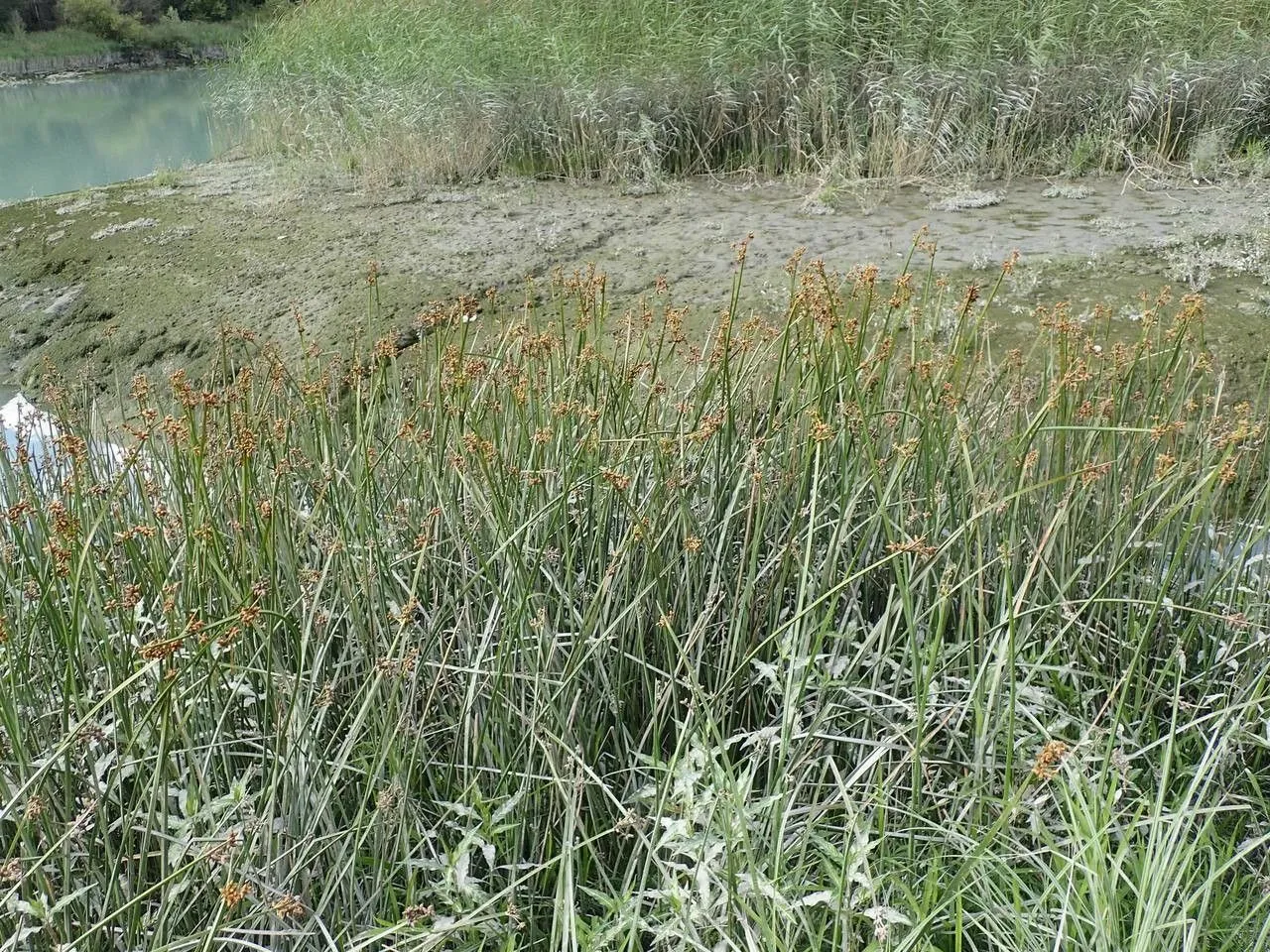
Author: (L.) Palla
Bibliography: Bot. Jahrb. Syst. 10: 299 (1888)
Year: 1888
Status: accepted
Rank: species
Genus: Schoenoplectus
Vegetable: False
Observations: Temp. Eurasia to India
The Triangular club-rush, scientifically known as Schoenoplectus triqueter, is a notable species within the Cyperaceae family. This perennial plant is recognized for its distinct triangular stems, which contribute to both its common and scientific names. The genus name Schoenoplectus derives from Greek roots suggesting ‘sedge’ and ‘woven,’ a nod to the plant’s traditional utilitarian uses, while triqueter pinpoints the triangular cross-section of its stems.
This plant is indigenous to temperate regions across Eurasia extending to the Indian subcontinent, where it thrives in marshy or aquatic environments. Its broad distribution highlights its adaptability to various wetland habitats, where it often forms dense stands. These environments are crucial for local ecosystems, providing habitat and food for a variety of wildlife.
The species was first thoroughly documented in scientific literature in 1888, specifically in volume ten of Botanische Jahrbücher für Systematik (Bot. Jahrb. Syst.), a respected botanical journal. The botanical authority behind its classification is denoted as (L.) Palla, indicating that the original scientists who described the species were Linnaeus (hence the L.), with additional taxonomic refinement by Palla.
In addition to its ecological role, Triangular club-rush has historically been used in utilitarian crafts such as matting, basketry, and other woven products. This is due to the durable and flexible nature of its stems. Though less common in modern utilitarian uses, the plant holds cultural and historical significance in regions where it is found.
Understanding and preserving this species is essential, not just for biodiversity but also for the continued health of wetland ecosystems and the cultural heritage of regions where traditional plant uses are still relevant. As with many wetland plants, conservation efforts are necessary to protect these habitats from encroaching development and climate change.
Deu: dreikantige teichsimse
Eng: streambank bulrush, triangular club-rush, chair-maker’s rush, triangular bulrush
Nld: driekantige bies
Fra: scirpe à tige trigone, scirpe triquètre, scirpe à tiges trigones, scirpe à trois angles
Cym: llafrwynen drichomel, llafrwynen drionglog
En: Triangular club-rush, Streambank bulrush, Chair-maker’s Rush, Triangular Bulrush
Ar: خب (خَبّ)، ديس (دِيس)، سمار (سَمار), سمار (سَمَّار، سُمَّار)
Zh: San leng shui cong
Nl: Driekantige bies
Fr: Scirpe à tige trigone, Scirpe Triquètre, Scirpe à Tiges Trigones, Scirpe à Trois Angles
De: Dreikantige Teichsimse, Dreikant-Teichsimse, Dreikantige Teichbinse, Dreikantiges Seeried
It: Lisca trigona
Cy: Llafrwynen Drichomel, Llafrwynen Drionglog
© copyright of the Board of Trustees of the Royal Botanic Gardens, Kew.
© copyright of the Board of Trustees of the Royal Botanic Gardens, Kew.
© copyright of the Board of Trustees of the Royal Botanic Gardens, Kew.
Taken Aug 10, 2017 by Yoan MARTIN (cc-by-sa)
Taken Aug 10, 2017 by Yoan MARTIN (cc-by-sa)
Taken Aug 10, 2017 by Yoan MARTIN (cc-by-sa)
Taken Aug 10, 2017 by Yoan MARTIN (cc-by-sa)
Taken Aug 10, 2017 by Yoan MARTIN (cc-by-sa)
Taken Oct 15, 2015 by Photoflora – Benoit BOCK (©)
Taken Oct 15, 2015 by Photoflora – Benoit BOCK (©)
Taken Oct 15, 2015 by Photoflora – Benoit BOCK (©)
Taken Aug 10, 2017 by Yoan MARTIN (cc-by-sa)
Taken Aug 10, 2017 by Yoan MARTIN (cc-by-sa)
Taken Aug 10, 2017 by Yoan MARTIN (cc-by-sa)
Taken Aug 10, 2017 by Yoan MARTIN (cc-by-sa)
Taken Aug 10, 2017 by Yoan MARTIN (cc-by-sa)
Taken Aug 10, 2017 by Yoan MARTIN (cc-by-sa)
Taken Aug 10, 2017 by Yoan MARTIN (cc-by-sa)
Taken Jun 3, 2019 by Klaas Langendoen (cc-by-sa)
Taken Jul 3, 2020 by Roland Pistor (cc-by-sa)
Taken Jul 13, 2019 by P M (cc-by-sa)
Taken Jan 1, 1900 by EOL − (cc-by-nc)
Taken Aug 11, 2022 by Andy Radnor (cc-by-sa)
Taken Jun 29, 2020 by Norman K (cc-by-sa)
Taken Jun 26, 2016 by Tela Botanica − Stephen LEROY (cc-by-sa)
Taken Jun 26, 2016 by Tela Botanica − Stephen LEROY (cc-by-sa)
Taken Jun 26, 2016 by Tela Botanica − Stephen LEROY (cc-by-sa)
Taken Aug 4, 2019 by horticulturist itqan khan (cc-by-sa)
Taken Oct 15, 2015 by Photoflora – Benoit BOCK (©)
Taken Oct 15, 2015 by Photoflora – Benoit BOCK (©)
Taken Oct 15, 2015 by Photoflora – Benoit BOCK (©)
Taken Jan 1, 1970 by Photoflora – L’Abbé COSTE (©)
Growth habit: Graminoid
Ph maximum: 7.5
Ph minimum: 7.0
Light: 8
Atmospheric humidity: 9
Bloom months: [‘jul’, ‘aug’, ‘sep’]
Soil nutriments: 7
Soil salinity: 2
Family: Myrtaceae Author: (F.Muell.) K.D.Hill & L.A.S.Johnson Bibliography: Telopea 6: 402 (1995) Year: 1995 Status:…
Family: Rubiaceae Author: Pierre ex A.Froehner Bibliography: Notizbl. Bot. Gart. Berlin-Dahlem 1: 237 (1897) Year:…
Family: Sapindaceae Author: Koidz. Bibliography: J. Coll. Sci. Imp. Univ. Tokyo 32(1): 38 (1911) Year:…
Family: Asteraceae Author: A.Gray Bibliography: Pacif. Railr. Rep.: 107 (1857) Year: 1857 Status: accepted Rank:…
Family: Fabaceae Author: Medik. Bibliography: Vorles. Churpfälz. Phys.-Ökon. Ges. 2: 398 (1787) Year: 1787 Status:…
Family: Aspleniaceae Author: (Cav.) Alston Bibliography: Bull. Misc. Inform. Kew 1932: 309 (1932) Year: 1932…